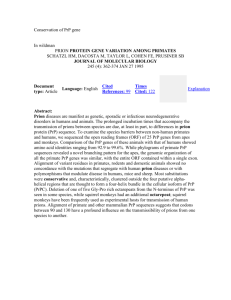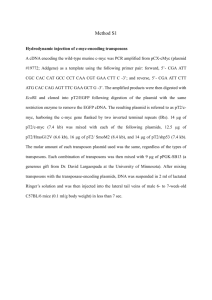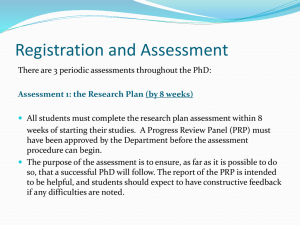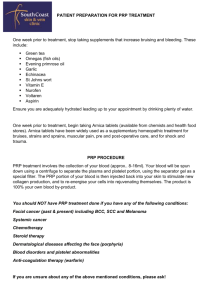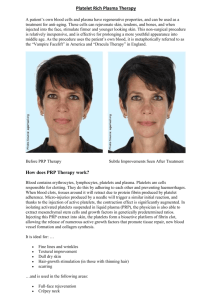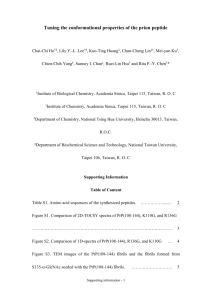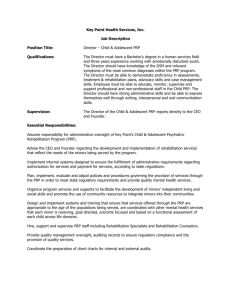Kaz Miyagiwa and Paul H. Rubin
advertisement
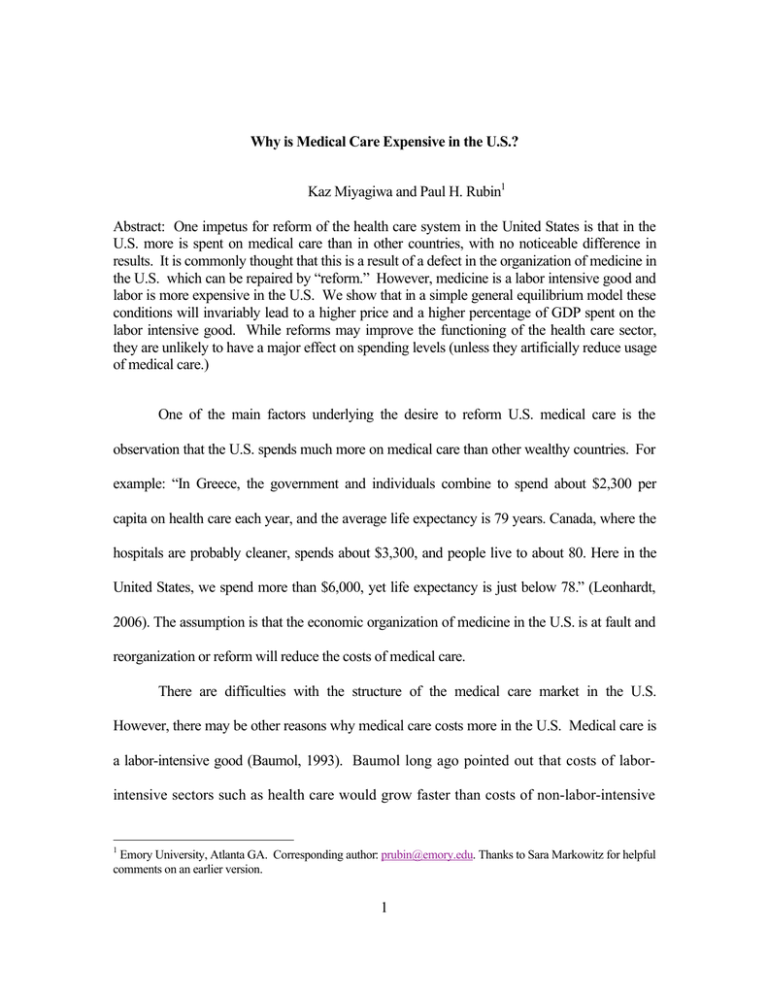
Why is Medical Care Expensive in the U.S.?
Kaz Miyagiwa and Paul H. Rubin1
Abstract: One impetus for reform of the health care system in the United States is that in the
U.S. more is spent on medical care than in other countries, with no noticeable difference in
results. It is commonly thought that this is a result of a defect in the organization of medicine in
the U.S. which can be repaired by “reform.” However, medicine is a labor intensive good and
labor is more expensive in the U.S. We show that in a simple general equilibrium model these
conditions will invariably lead to a higher price and a higher percentage of GDP spent on the
labor intensive good. While reforms may improve the functioning of the health care sector,
they are unlikely to have a major effect on spending levels (unless they artificially reduce usage
of medical care.)
One of the main factors underlying the desire to reform U.S. medical care is the
observation that the U.S. spends much more on medical care than other wealthy countries. For
example: “In Greece, the government and individuals combine to spend about $2,300 per
capita on health care each year, and the average life expectancy is 79 years. Canada, where the
hospitals are probably cleaner, spends about $3,300, and people live to about 80. Here in the
United States, we spend more than $6,000, yet life expectancy is just below 78.” (Leonhardt,
2006). The assumption is that the economic organization of medicine in the U.S. is at fault and
reorganization or reform will reduce the costs of medical care.
There are difficulties with the structure of the medical care market in the U.S.
However, there may be other reasons why medical care costs more in the U.S. Medical care is
a labor-intensive good (Baumol, 1993). Baumol long ago pointed out that costs of laborintensive sectors such as health care would grow faster than costs of non-labor-intensive
1
Emory University, Atlanta GA. Corresponding author: prubin@emory.edu. Thanks to Sara Markowitz for helpful
comments on an earlier version.
1
goods. Our argument here is related but different. We deal with the level of costs, not
their growth, although our model is consistent with Baumol’s if we apply ours to the
issue of growth. Our point is that the costs of labor-intensive goods will be higher in high
wage economies. This higher level of costs is a result of the technology of production
and the normal functioning of markets.
We show this in a simple general equilibrium model. Suppose there are two
countries, England and the U.S. Both countries produce two goods, medical care and a
numeraire good using two factors, capital and labor. Medicine is “labor-intensive” relative
to the numeraire good. Capital and labor are fixed in supply and freely mobile within each
country. Perfect competition (or monopolistic competition) prevails everywhere. Technologies
exhibit constant returns to scale and are identical across countries. Medicine is not traded
internationally. The U.S. is richer and so has more capital per capita. Under these
conditions we claim:
Proposition: Suppose that medicine is a luxury good (with income elasticity no less than unity)
and is price insensitive. Then Americans pay a higher price for medicine and yet spend a
greater fraction of income on medicine compared with Britons.
Proof. We first present a general equilibrium model using dual functions (Dixit and Norman
1980). We provide a proof for the pure competition case, but due to the isomorphism between
perfect competition and monopolistic competition (Dixit and Norman 1980), the result holds
even if medical care industry is characterized by monopolistic competition.
2
Let k be the stock of capital, p be the relative price of medicine, and u be the aggregate utility.
Then the income expenditure identity is
(1)
e(p, u) = r(p, k)
where e is the aggregate (minimum) expenditure function and r is the (maximum) GDP
function. Both are continuously differentiable. The market clearing condition is
(2)
ep(p, u) = rp(p, k)
where subscripts denote partial derivatives. Here ep is (Hicksian) demand for medicine and rp
its supply. Equations (1) and (2) completely specify the equilibrium. In particular, they
determine the equilibrium p in terms of k.
There is more capital in America than in England. To see the effect of this endowment
difference on the price of medicine, first differentiate (1) to obtain
(3)
eudu/dk = rk,
where rk measures the price of capital and is positive. Differentiate (2) next to obtain
epudu/dk + Sdp/dk = rpk
where
S = epp – rpp < 0.
Substituting from (3) yields the difference in the price of medicine in two countries:
(4)
dp/dk = (rpk - epudu/dk)/S = (rpk – rkepu/eu)/S.
To sign the right-hand side, first observe that medicine being labor intensive implies rpk < 0;
this is the standard Rybczynski effect. Note next that epu/eu is the income effect on medicine. If
3
m denotes ordinary demand for medicine and y income, we have epu/eu = ∂m/∂y = my > 0
since medicine is not an inferior good. Then, since S < 0, we have that dp/dk > 0; The price of
medicine is higher in the U.S. than in Britain. This proves the first part of the proposition.
To prove that Americans spend a larger fraction of income on medicine under the
assumptions of the proposition, let q denote the expenditure share of medicine, that is,
q = pm/r = prp(p, k)/r(p, k),
where rp = m in equilibrium. Differentiation shows that
dq/dk = N/r2
where
N = r[(rp + prpp)dp/dk + prpk] – prp(rpdp/dk + rk)
(5)
= (rrp + prrpp – prp2)dp/dk + p(rrpk – rprk)
Substituting for dp/dk from (4) and collecting terms yields
N = {(rrp + prrpp – prp2)(rpk – rkmy)/S + p(rrpk – rprk)
(6)
= (rpk/S)[rrp + prrpp – prp2 + prS] – (rk/S)[my(rrp + prrpp – prp2) + prpS].
Since rpk/S > 0 and rk/S < 0, N is positive if the two expressions in brackets on the right of (6)
are both positive. The first bracketed expression is written as
rrp + prrpp – prp2 + prS
= rrp + prrpp – prp2 + prepp - prrpp
(7)
= rp(r – prp) + prepp.
4
The first term in (7) is positive so (7) is positive if e is sufficiently small. The second bracketed
expression in (6) is rewritten
my(rrp + prrpp – prp2) + prpS
= rp[my (r + prrpp/rp – prp) + pepp – prpp]
= rp[my (r – prp) + my prrpp/rp + pepp – prpp].
Since rp > 0, the sign of the above expression depends on the sign of the expression in brackets,
which can be rewritten as follows:
my (r – prp) + my prrpp/rp + pepp – prpp
= my (r – prp) + pepp + prpp(my r/rp – 1)
(8)
= my (r – prp) + pepp + prpp(my r/m – 1).
The first term in (8) is positive, while the second is negative. The third term is nonnegative
because the income elasticity of demand for medicine η = my r/m ≥ 1. Thus, again (8) is
positive if epp is sufficiently small.
To make the conditions “epp sufficiently small” more precise, we first rewrite (7) as
rp(r – prp) + prepp = rp(r – prp) – repθ = rp{(r – prp) – rθ} = rrp{(1 – q) – θ}.
The first equality holds by the definition of the price elasticity of Hicksian demand for
medicine θ = - pepp/ep. The second results from the equilibrium condition (2). The third
follows from the definition of q. Thus, (7) is positive if 1 – q > θ.
5
Turning to (8), note that the last term is non-negative, given that η ≥ 1. As for the first
two terms of (8), the following inequality holds
(9)
my (r – prp) + pepp ≥ (m/r)(r – prp) + pepp
because η = my r/m ≥ 1 implies that my ≥ m/r > 0. Further, the right hand side of (9) can be
written as
(10)
(m/r)(r – prp) + pepp = (rp/r)(r – prp) + pepp = (1/r)[rp(r – prp) + prepp].
The bracketed expression in (1) is identical to that in (7). Thus, we conclude that 1 – q > θ
implies N > 0 and hence dq/dk > 0.
Finally, by the standard operations the Slutsky equation
epp = m + my(p, y)m
can be expressed as
(11)
- θ = - ε + qη,
where ε = - pmp/m is the price elasticity of Marshallian demand for medicine. Substituting
from (11), we can express the condition 1 – q > θ as
1 + q(η - 1) > ε,
which is fulfilled, given that η ≥ 1 and ε < 1. This completes the proof.
Recent data shows that the income elasticity of medicine is above 1, and generally
estimated at about 1.3 (Getzen, 2010, p. 311), whereas the price elasticity is clearly less than
6
unity, generally estimated at between 0 and .5 (Getzen, 2010, p. 45). Thus, the conditions of
the proposition are clearly met.
Thus, the fact that Americans are paying disproportionately more for medicine may be
a simple reflection of the nature of the economy, not of flaws in the market system. In other
words, if this analysis is correct, we cannot expect major changes in expenditure patterns as a
result of reforms, whether they are the sort of reforms associated with “Obamacare” or the
more premarket reforms favored by the Republicans. In either case, delivery of medical care
may become more or less efficient, and there may be other costs and benefits, but a major shift
in spending patterns is not likely to occur. Differences in spending patterns across countries
noted by critics are due to inherent structural differences in the economies, not to any particular
flaw in the American organization of medical care.
References:
Baumol, William J. (1993), “Health Care, Education and the Cost Disease: A Looming
Crisis for Public Choice,” Public Choice, Vol. 77, No. 1, (Sep., 1993), pp. 17-28.
Dixit, A. K and V. Norman (1980), Theory of International Trade (Oxford).
Getzen, Thomas E. (2010), Health Economics and Financing (Fourth Edition), Wiley.
Leonhardt, David (2006), “A Lesson From Europe on Health Care,” New York Times, October
18.
7

